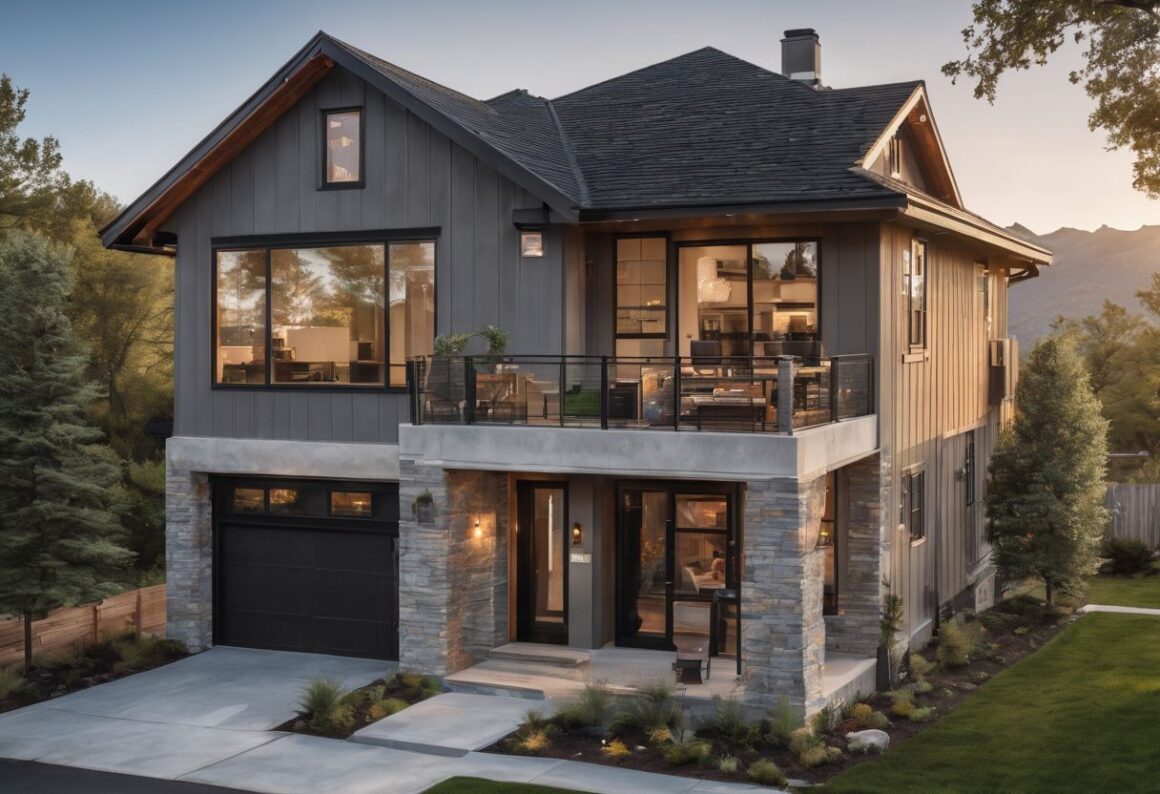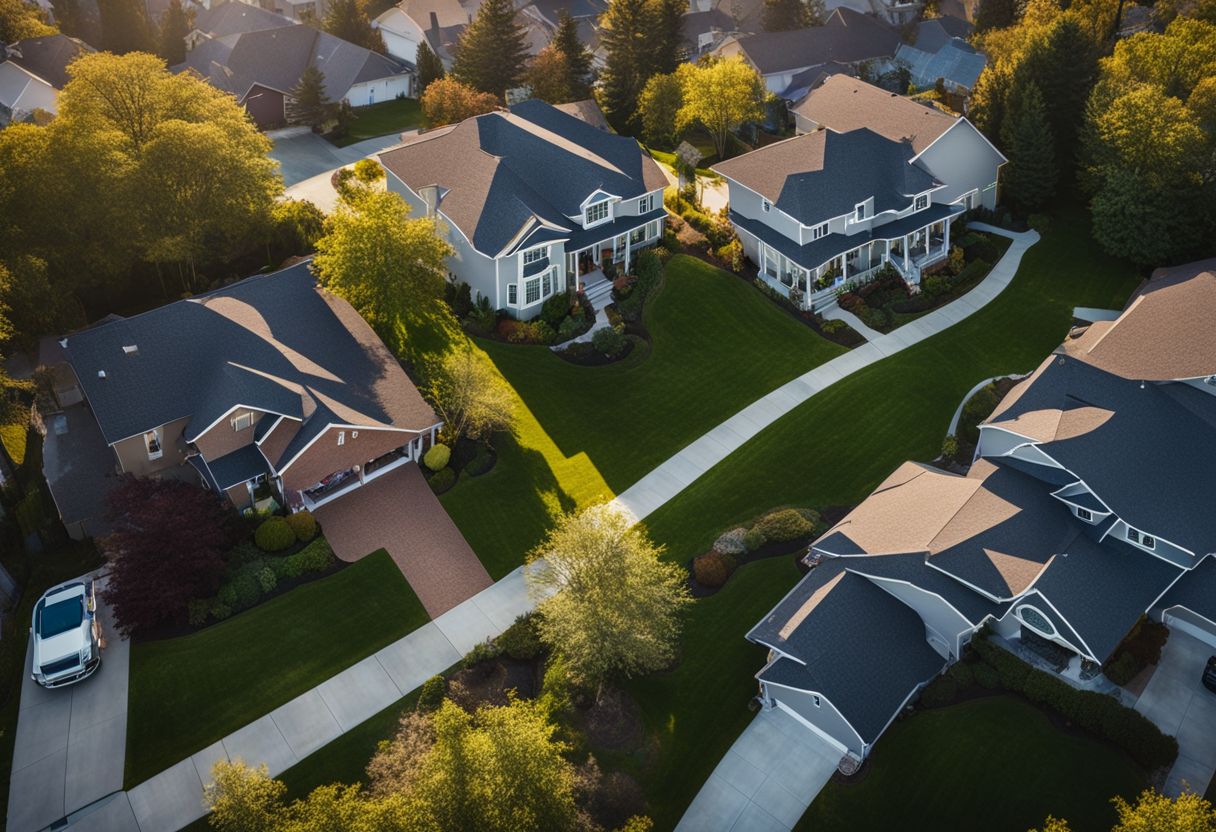Have you ever looked at a two-story house and wondered just how tall it is? A typical two-story home stands proud between 18 and 25 feet high, which can be quite the landmark in any neighborhood.
This article will guide you through the mix of factors that determine that height, from roof pitch to floor thickness. Discover the true stature of your dream home — read on!
Main Outcomes
• Two – story houses are usually 20 to 25 feet tall, or about 6.1 to 7.6 meters.
• The height of a two – story house can change because of the foundation, roof style, floor thickness, attic space, and ceiling heights.
• Having a two – story home means more living space and has benefits like better views and separate areas for private and public activities.
The Average Height of a Two-Story House
When it comes to understanding the general scale of residential architecture, knowing the average height of a two-story house is essential. Typically, these structures stand between 20 to 25 feet tall, which translates to roughly 6.096 to 7.62 meters in metric terms.
Between 20 to 25 feet
Most two-story houses stand 20 to 25 feet tall. This height includes from the ground to the top of the roof. When you convert these numbers, it means a two-story house can be about 6.096 meters to 7.62 meters high.
The exact height can change based on things like how big your rooms are or what type of roof your house has.
A house that is this tall gives each floor enough space for people to move around comfortably. Most times, ceilings in homes are about 8 feet high for each story, but some can be as much as 10 feet if you want more space overhead or have special design needs.
So when we add all parts together—like floors and attic—the total height reaches between those average figures of 20 to 25 feet.
Converted to 6.096 to 7.62 meters
A two-story house is not just measured in feet. If you use meters, the average height will be about 6.1 to 7.6 meters tall. This means when a person talks about building or buying a home, they might say it’s around 20 to 25 feet high or translate that to these meter measurements.
This change from feet to meters helps people who use the metric system understand how tall a two-story house is. Since some places and tools measure only in meters, knowing this range makes planning easier for everyone around the world.
Factors Affecting the Height of Two-Story Homes
When you’re considering the height of a two-story house, there are several key elements that come into play beyond just the standard floor-to-ceiling measurements. Each factor, from foundation depth to roof pitch, uniquely contributes to determining the final stature of a residential building.
Foundation height
The bottom of a house is called the foundation. This part can change how tall the house stands above the ground. Floods and sewage systems can make builders raise the foundation. More room on each floor means a taller foundation too.
When making it, they think about what materials to use, if the soil is strong enough, and how big the base should be. Sometimes for bigger houses with three stories, they make even more space at the bottom to fit everything well.
Building codes also play a key role in setting this height. They have rules that say how high off the ground your home needs to be for safety and comfort reasons. Builders check these rules before starting work on any new house or building upgrades so everyone living there will be safe and happy with their home’s size from bottom to top.
Roof style and pitch
Just like the foundation can change a house’s height, so can the roof. Roof style and pitch matter a lot. Some roofs are flat and don’t add much height. But if the roof is angled or steep, it makes the house taller.
A big angle means there’s more space under the roof, which might be used for an attic.
Roof pitch also affects how your home looks and works. For example, in snowy places, steep roofs help snow slide off faster. This means when you’re planning to build or change a roof, you should think about how high you want your home to be and what the weather is like where you live.
Thickness of the floor
The floor thickness also plays a part in how tall a two-story house is. In some houses, the space between the ground and upper floor can be about 1 foot thick. This includes the beams that hold up the second story and any materials that cover them like wood or carpet.
Floors must be strong enough to support furniture and people walking on them. They may have layers with things like insulation to keep heat in during winter or cool air in during summer.
This extra layering can add more height to your home’s overall size without you seeing it from outside.
Attic space
Attic space can change how tall a two-story house is. Sometimes, people use their attic for storage. They might just have a small area between the roof and ceiling. Other times, they make the attic into an extra room.
This can make the house taller because they need to fit stairs and have enough space to stand up in it.
A nice big attic makes a home feel special. It gives more room for things or even a place to hang out. When builders design houses, they think about how much attic space you want and that helps them decide how tall your two-story house will be.
First-floor ceiling height
The first floor of a two-story house usually has ceilings that are 8 to 10 feet tall. This height can help decide how tall the whole house will be. People like taller ceilings because they make rooms feel bigger and more open.
After World War II, most houses started having ceilings that were eight feet high. This became normal when they built lots of homes at once. The size of the room and what you do in it should guide how high your ceiling is.
High first-floor ceilings could lead to needing stairs with more steps to reach the second story.
Second-floor height
Ceilings on the second floor are often eight feet high, like those on the first. But if people want higher ceilings or need extra space for things like air vents, the height can be more.
The total height of a two-story house changes if this floor is taller. Houses might add features in between floors too. These could make room for wires, heating ducts, and good soundproofing.
Homes with an attic above the second story may have even more height to work with. Builders sometimes count this space when they measure how tall a house stands. If you’re building or buying a home, think about what you’ll use each level for.
Choosing ceiling heights that fit your life will shape how cozy and useful your rooms feel.
Benefits of Living in a Two-Story Home
Discover the perks of vertical living; a two-story home not only maximizes your footprint but also offers distinct areas for privacy, entertainment, and possibly some stunning elevated views that single-level homes can’t match.
More space for living
Two-story homes give you lots of room to live. You get more floor space without taking up extra land. This means you can have big bedrooms, more bathrooms, and maybe even a play area for kids.
Since the house has two levels, it can also make people happier with where they live.
Living in a two-story home lets families split spaces better. For example, sleeping areas can be upstairs and living or dining rooms downstairs. Everyone gets their own spot which is nice for privacy and organization.
Plus, not having everything on one level cuts down on noise across different rooms!
Better division of living spaces
Having a two-story home means you can split up your space well. You might have bedrooms on the top floor and places to hang out like the living room or kitchen on the bottom. This setup keeps private rooms away from busier spots, which can be good when you need some quiet time.
Houses with more levels are great for families because everyone can have their own area without getting in each other’s way. Now let’s look at how awesome it is to see things from up high in a two-story home!
Potential for views
Living in a two-story house often means you can see more from your windows. You might spot trees, hills, or even the city skyline from the second floor. This can make your home feel special and connected to the outside world.
With higher walls and taller windows, a two-story home lets in lots of light and allows you to enjoy scenes that people living on lower levels might miss out on.
Townhouses are good for views too. They have several floors stacked up tall. This design gives many townhouses nice views from different rooms, like bedrooms upstairs or kitchens down below.
If a townhouse is part of your life, you could look out over parks or streets without leaving home. Higher stories mean your eyes can travel further when you gaze out into the world.
How Does the Height of a Two-Story House Compare to Other Homes?
Discovering how the stature of a two-story home measures up against other residential buildings offers intriguing insight; keep reading to explore this architectural comparison further.
Average height of a one-story house
The average height of a one-story house stands at about 10 to 15 feet. This is roughly the same as 3 to almost 5 meters tall. These homes often have a flat or slightly sloped roof.
Local building codes play a big role in setting this minimum height. For many people, this size is just right for living on one level without needing stairs.
Ceilings inside these houses are usually around 8 feet high, which leaves enough space above and below for things like wires and pipes. The whole house ends up being taller than the ceiling because of the extra bits like the roof and foundation.
So when you look at it from outside, it might seem taller than just where the ceiling ends inside.
Average height of a three-story house
A three-story house usually stands about 27 feet tall. This height is often split into 9 feet for each level of the home. However, if you look at bigger buildings labeled as “3-story,” they might reach up to 45 feet high because their stories can be around 15 feet each.
These taller stories could be due to higher ceilings or extra features like thick floors.
If you have a three-story house with a flat roof, it will be closer to the lower end of that range. But add in something like a pitched roof, and your house could stretch even taller before it touches the sky.
Now let’s compare this to how much space one- and two-story homes take up.
FAQs
1. How tall is a two-story house?
A two-story house typically has an overall height between 20 feet to 35 feet, depending on the ceiling and roof design.
2. What affects how tall a two-story house can be?
The height of each floor, including the first story and second floor, as well as the pitch of the roof, can affect the total height of a two-story home.
3. Can I measure how tall my 2-story house is?
Yes, you can measure from the ground to the top of your house to find out its height, but remember to include both stories and the roof!
4. Is there an average height for a two-story building?
Most often, an average two-story residential building has a height that ranges around 18 to 20 feet per story with additional space for the roof.
5. Why might one two-story home be taller than another?
Some houses may have taller ceilings or different styles of roofs which can make one higher than another even if they both have two stories.
6. Do all countries have similar heights for their houses?
No! Height standards for buildings like homes might vary depending on where a house is built or local rules about how high you can build.
Conclusion
In closing, a two-story house is usually 20 to 25 feet tall. Remember that things like the roof and the floor thickness change how tall it gets. When you build or buy this kind of home, think about all these parts.
They help you know just how big your house will be. So, every two-story house can look very different from another!

Rosemarie Rich is an accomplished editor with a passion for all things home and design. Armed with a bachelor’s degree in interior design from the prestigious New York School of Interior Design, she embarked on a journey that seamlessly blended her creative talents with her love for the written word.
With a career spanning over a decade, Rosemarie has honed her skills as both a writer and an editorial professional in the realm of home decor and design. Her keen eye for aesthetics and her deep understanding of design principles have made her a respected authority in the industry.
As the editor of Home and The Abound Blog, Rosemarie has curated content that inspires and informs readers, offering them invaluable insights into creating spaces that are both functional and beautiful. Her dedication to her craft is evident in the thoughtful articles and features she produces, each one showcasing her expertise and passion for design.
Beyond her editorial endeavors, Rosemarie is also known for her collaborative spirit, often working closely with designers, architects, and other industry professionals to bring fresh ideas to the forefront. Her commitment to excellence and her unwavering dedication to her craft continue to make her a driving force in the world of home and design.




